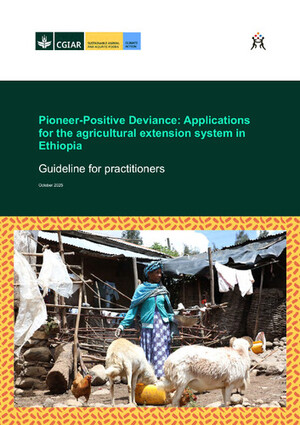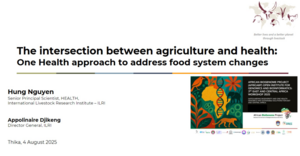
Recent locust swarms highlight the importance of livestock in east Africa
In December 2019, and continuing through most of 2020, locust swarms periodically blotted the skies above east Africa. The invasion formed in the Arabian Desert in May 2018, with strong winds eventually pushing the insects across the Red Sea and into east Africa, generating a plague on a scale not seen in generations. ‘Locust invasions of this magnitude are a new phenomenon for many people’, explains Watson Lepariyo, a research associate with ILRI from Samburu, Kenya. The locust invasions were the largest Kenya had experienced in the last 70 years. As they decimated the region’s crops and put more than 13-million people across seven east African countries at risk of severe food insecurity, the nutritional and financial value of livestock became increasingly important to people’s survival.
Desert locusts (Schistocerca gregaria) are perhaps the world’s most devastating pests. A single swarm can cover up to 1,200 square kilometres and contain between 40 and 80 million locusts per square kilometre. With each locust eating around 2 grams of food every day (roughly the weight of one American dime), a locust swarm can consume more food in a day than 35,000 people. By February 2020, locusts in Kenya were eating the same amount of food per day as the country’s entire human population. In neighbouring Ethiopia, many farmers experienced 100 per cent crop losses, while others were forced to harvest before their crops had fully matured.
With much of the cropland across east Africa destroyed, livestock became increasingly vital to rural livelihoods. Livestock are not only culturally significant in many east African communities, but they are also essential sources of food, nutrition and income. In contrast to crops, which are helpless against swarming locusts, livestock are a mobile and resilient source of value. ‘When you need income, or when you need that income to be liquid, you can dispose of the number of cattle that you want to get the income you need’, explains Lepariyo. In this way, livestock serve as a ‘walking savings bank’ that farmers can rely on in the wake of unforeseen shocks. This became particularly useful in the aftermath of the locust invasions when many farmers turned to their livestock for income and nutritional security as the region’s croplands lay bare.
This is not all to say that livestock farmers were immune to the locust plagues. In fact, locusts impacted nearly 300,000 acres of pasture in the Kenyan counties of Wajir, Isiolo and Meru. In villages unfortunate enough to find themselves at the heart of a locust breeding ground, entire fields were sometimes stripped bare, threatening the area’s livestock and people with starvation.
Fortunately, because the locusts gathered during the unusually long rainy season that started in 2019 and lasted into 2020, plenty of healthy pasturelands and palatable plants remained in the region. While the locusts devastated the pastureland in certain villages, Lepariyo notes that the abundant vegetative conditions ensured that ‘even if the locusts deplete some pasture as they are migrating, in most cases it is not in amounts that deplete the pasture completely for livestock’. And because prevailing wind patterns determine a swarm’s migration path, locusts can decimate one village while leaving neighbouring villages completely untouched. This ensured that farmers who lost their traditional grazing areas to the locusts could move their livestock to nearby areas that still supported healthy pastures.
While this movement was often necessary for farmers’ survival, it may have opened the door for resource-based conflict. In areas with no secure property rights, conflict between pastoral communities is already a growing problem due to the economic insecurity caused by the COVID-19 pandemic and the steady degradation of the region’s rangelands. The locust swarms have worsened both economic insecurity and rangeland health across east Africa, boosting the potential for future conflict and raising the importance of developing sustainable and practical solutions to future invasions.
The current international response to locusts is to spray infested areas with pesticides. Hundreds of thousands of gallons have already been sprayed across east Africa as the pesticide campaign continues in 2021. Pesticides are often effective in reducing the size of swarms, but the consequences of this amount of pesticide use to human, animal and environmental health are still unknown.
While damage assessments remain incomplete, a recent UN review of pesticide use in east Africa determined the environmental risk to be ‘substantial’. Additionally, an ILRI study from India found that pesticides accumulate in bovine milk, thereby posing a serious threat to human health and particularly children. Confirming these risks, Lepariyo notes that ‘pesticides used to control breeding of the desert locust could have health effects, so we need to better understand how they affect livestock products and consequently affect humans’. Another important consideration is pesticide’s impact on bees. Kenya is renowned for its bee diversity, which is crucial to the health of rangelands and the rural livelihoods they support. However, scientists are already warning that the use of pesticides to control locusts is having devastating effects on local bee populations.
To prevent locust swarms from ever reaching the point where large-scale pesticide use again becomes necessary, many scientists are instead focused on prediction. Organizations like the FAO are working to forecast locust plagues by tracking weather patterns, such as cyclones and heavy rains, that can make swarms more likely to form. While the science is still inexact, future improvements in locust swarm forecasting could help scientists detect locusts at their source when the fledgling swarms can still be tempered by small, targeted pesticide campaigns or more environmentally friendly control mechanisms, such as microbial biopesticides. This would stop the swarms from growing and eventually spreading to other regions.
However, these measures still do not address what many scientists believe is the root cause of the crisis: climate change. 2019 was one of east Africa’s hottest and wettest years on record. Heavy rainfall and warm temperatures created favourable conditions for desert locusts which require wet soils and lush vegetation to breed extensively, despite originating in dry environments. ‘They could not have spread as much as they did if these conditions were not so favourable,’ explains Lepariyo. Environmental degradation, overgrazing, deforestation and desertification, in conjunction with increasingly warm and wet conditions, make east Africa an ideal breeding ground for locusts. While many other species may struggle to survive against these harsh conditions, locusts will continue to thrive, and their numbers will grow as they face decreased competition from other insects unable to adapt to a rapidly warming climate.
Locust swarms’ connection to climate change and environmental degradation underlines the importance of sustainable agricultural practices in east Africa. Since the region’s last locust swarm of this magnitude, vast swaths of productive rangelands have been converted to crops. This large-scale land conversion has not only contributed to deforestation and desertification, but it has also left rural livelihoods and nutritional security more susceptible to the wrath of locusts, which feast on cropland. The environmental benefits of sustainable livestock keeping can help reverse land degradation, deforestation and desertification, making it more difficult for locusts to thrive in east Africa. Sustainable livestock can also strengthen the region’s nutritional and financial resilience to future swarms by improving rangeland health and increasing sustainable production of livestock-derived foods (LDFs).
Looking to the future, Lepariyo notes that while the unusually devastating locust swarms of 2020 may look like an isolated phenomenon, ‘you cannot write them off and say it will not happen again’. The warming Indian Ocean, driven by climate change, has spawned highly active cyclones and heavy rains over the past few years. These conditions are favourable to breeding locusts, prompting many scientists to predict that east Africa will experience increasingly frequent locust swarms in the years to come. This is an ominous prediction, as UN reports reveal that if these swarms are allowed to spread, they have the potential to impact 20 per cent of Earth’s land surface, more than 65 of the world’s poorest countries and damage the livelihoods of 10 per cent of the world’s population. Faced with these challenges, sustainable livestock will have an important role in protecting the food security and livelihoods of millions of people across east Africa and across the world.
Related Stories
New drought-tolerant varieties rekindle hopes of food security in drought-prone Makueni County
One Health: Key to sustainable livestock—and human and environment—health
Keeping safe while staying food secure in Kenya
Photo credit: Axel Fassio/CIFOR



















